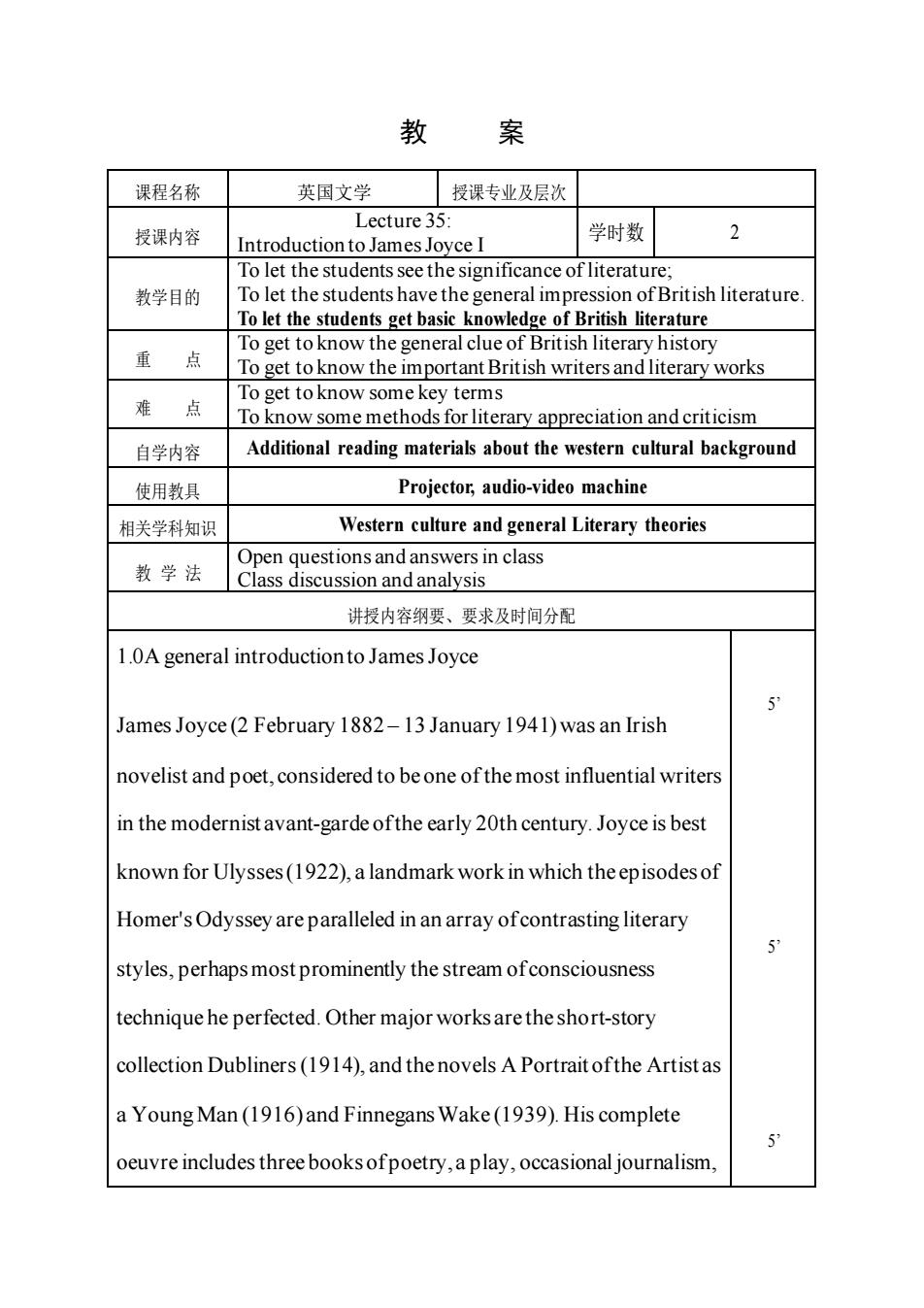
教 案 课程名称 英因文学 授课专业及层次 授课内容 Lecture 35: Introduction to James Joyce I 学时数 2 To let the students see the significance of literature; 教学目的 Toet the studentshave the of To let the students get basic knowledge of British literature 重点 To get to know the general clue of British literary history To get to know the important British writers and literary works 难点 To get to know some key terms Toknowsomemthodsforrary appreciationnditcsm 自学内容 Additional reading materials about the western cultural background 使用教具 Projector,audio-video machine 相关学科知识 Western culture and general Literary theories Open questions and answers in class 教学法Class discussion and analysis 讲授内容纲要、要求及时间分配 1.0A general introductionto James Joyce ames Joyce(2 February 1882-13 January 1941)was an Irish novelist and poet,considered to be one of the most influential writers in the modernist avant-garde ofthe early 20th century.Joyce is best known for Ulysses(1922),a landmark work in which theepisodes of Homer's Odyssey are paralleled in an array ofcontrasting literary 5 styles,perhaps most prominently the stream ofconsciousness technique he perfected.Other major worksare theshort-story collection Dubliners(1914),and the novels A Portrait ofthe Artistas a Young Man(1916)and Finnegans Wake(1939).His complete oeuvre includes three booksofpoetry,aplay,occasional journalism
教 案 课程名称 英国文学 授课专业及层次 授课内容 Lecture 35: Introduction to James Joyce I 学时数 2 教学目的 To let the students see the significance of literature; To let the students have the general impression of British literature. To let the students get basic knowledge of British literature 重 点 To get to know the general clue of British literary history To get to know the important British writers and literary works 难 点 To get to know some key terms To know some methods for literary appreciation and criticism 自学内容 Additional reading materials about the western cultural background 使用教具 Projector, audio-video machine 相关学科知识 Western culture and general Literary theories 教 学 法 Open questions and answers in class Class discussion and analysis 讲授内容纲要、要求及时间分配 1.0A general introduction to James Joyce James Joyce (2 February 1882 – 13 January 1941) was an Irish novelist and poet, considered to be one of the most influential writers in the modernist avant-garde of the early 20th century. Joyce is best known for Ulysses(1922), a landmark work in which the episodes of Homer'sOdyssey are paralleled in an array of contrasting literary styles, perhaps most prominently the stream of consciousness technique he perfected. Other major works are the short-story collection Dubliners (1914), and the novels A Portrait of the Artist as a Young Man (1916) and Finnegans Wake (1939). His complete oeuvre includes three books of poetry, a play, occasional journalism, 5’ 5’ 5’
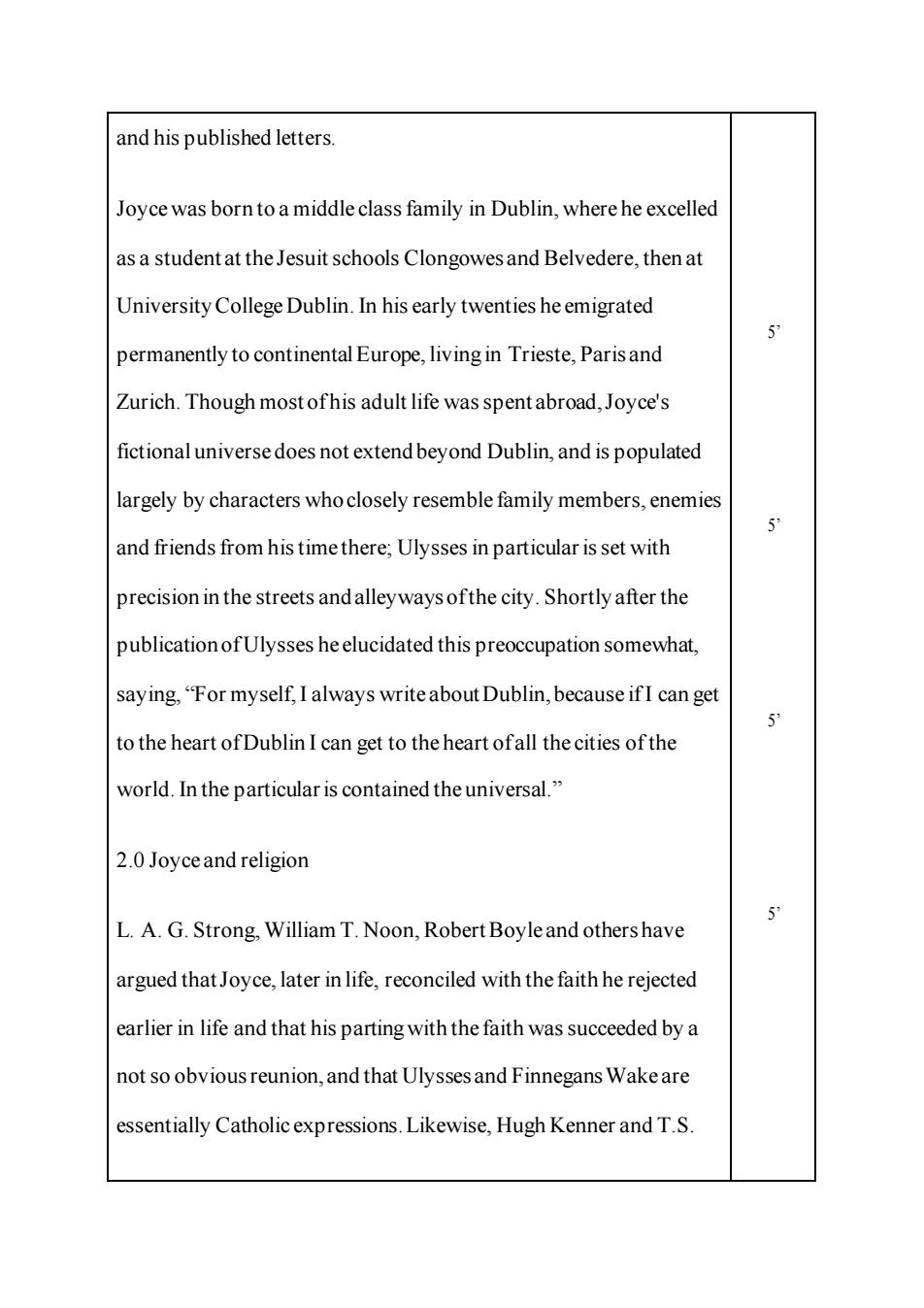
and his published letters. Joyce was born to a middle class family in Dublin,where he excelled as a student at the Jesuit schools Clongowesand Belvedere,then at University College Dublin.In his early twenties he emigrated 5 permanently to continental Europe,living in Trieste,Paris and Zurich.Though most ofhis adult life was spentabroad.Joyce's fictional universe does not extend beyond Dublin,and is populated largely by characters who closely resemble family members,enemies 5 and friends from his timethere;Ulysses in particular is set with precision in the streets and alleyways ofthe city.Shortly after the publication ofUlysses heelucidated this preoccupation somewhat, saying,"For myself,I always writeabout Dublin,because ifI can get 5 to the heart ofDublin I can get to the heart ofall the cities ofthe world.In the particular is contained the universal." 2.0 Joyceandreligion 5 L.A.G.Strong,William T.Noon,Robert Boyleand others have argued that Joyce,later in life,reconciled with the faith he rejected earlier in life and that his parting with the faith was succeeded by a not so obvious reunion,and that Ulysses and Finnegans Wake are ssentially Catholic expressions.Likewise,Hugh Kenner and T.S
and his published letters. Joyce was born to a middle class family in Dublin, where he excelled as a student at the Jesuit schools Clongowes and Belvedere, then at University College Dublin. In his early twenties he emigrated permanently to continental Europe, living in Trieste, Paris and Zurich. Though most of his adult life was spent abroad, Joyce's fictional universe does not extend beyond Dublin, and is populated largely by characters who closely resemble family members, enemies and friends from his time there; Ulysses in particular is set with precision in the streets and alleyways of the city. Shortly after the publication of Ulysses he elucidated this preoccupation somewhat, saying, “For myself, I always write about Dublin, because if I can get to the heart of Dublin I can get to the heart of all the cities of the world. In the particular is contained the universal.” 2.0 Joyce and religion L. A. G. Strong, William T. Noon, Robert Boyle and others have argued that Joyce, later in life, reconciled with the faith he rejected earlier in life and that his parting with the faith was succeeded by a not so obvious reunion, and that Ulysses and Finnegans Wake are essentially Catholic expressions. Likewise, Hugh Kenner and T.S. 5’ 5’ 5’ 5’
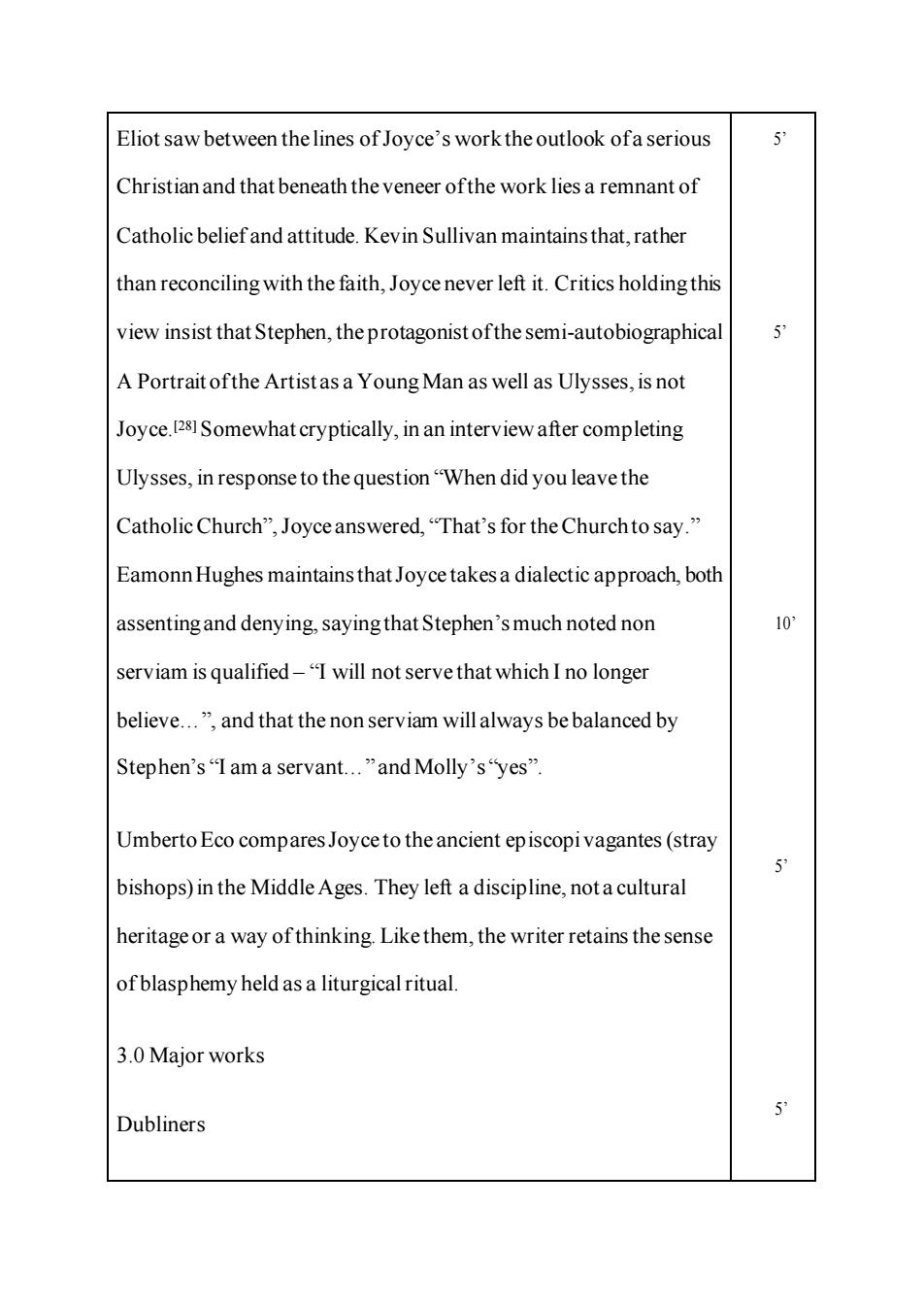
Eliot saw between thelines of Joyce's workthe outlook ofa serious Christian and that beneath the veneer ofthe work lies a remnant of Catholic beliefand attitude.Kevin Sullivan maintains that,rather than reconciling with the faith,Joyce never left it.Critics holdingthis view insist that Stephen,the protagonist ofthe semi-autobiographical A Portrait ofthe Artistas a Young Man as well as Ulysses,is not Joyce.2Somewhat cryptically,in an interview after completing Ulysses,in response to the question"When did you leave the Catholic Church",Joyceanswered,"That's for the Churchto say." Eamonn Hughes maintains that Joyce takesa dialectic approach,both assenting and denying,saying that Stephen's much noted non to. serviam is qualified-"I will not serve that which I no longer believe.",and that the non serviam will always be balanced by Stephen's"I am a servant.”and Molly'syes”. Umberto Eco compares Joyceto the ancient episcopi vagantes(stray 5 bishops)in the Middle Ages.They left a discipline,nota cultural heritage or a way of thinking.Likethem,the writer retains the sense of blasphemy held as a liturgical ritual. 3.0 Major works Dubliners 5
Eliot saw between the lines of Joyce’s work the outlook of a serious Christian and that beneath the veneer of the work lies a remnant of Catholic belief and attitude. Kevin Sullivan maintains that, rather than reconciling with the faith, Joyce never left it. Critics holding this view insist that Stephen, the protagonist of the semi-autobiographical A Portrait of the Artist as a Young Man as well as Ulysses, is not Joyce.[28] Somewhat cryptically, in an interview after completing Ulysses, in response to the question “When did you leave the Catholic Church”, Joyce answered, “That’s for the Church to say.” Eamonn Hughes maintains that Joyce takes a dialectic approach, both assenting and denying, saying that Stephen’s much noted non serviam is qualified – “I will not serve that which I no longer believe.”, and that the non serviam will always be balanced by Stephen’s “I am a servant.” and Molly’s “yes”. Umberto Eco compares Joyce to the ancient episcopi vagantes (stray bishops) in the Middle Ages. They left a discipline, not a cultural heritage or a way of thinking. Like them, the writer retains the sense of blasphemy held as a liturgical ritual. 3.0 Major works Dubliners 5’ 5’ 10’ 5’ 5’
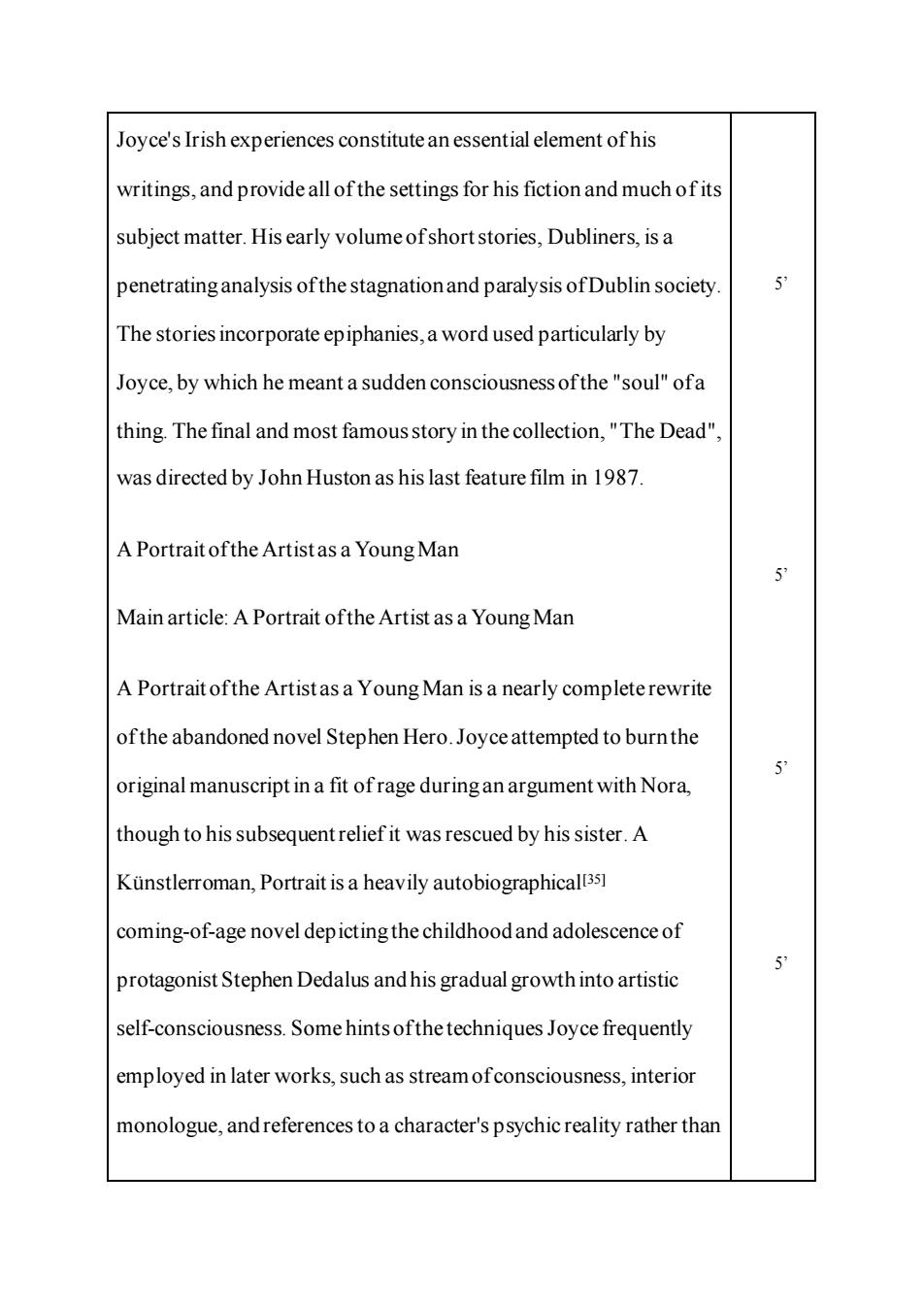
Joyce's Irish experiences constituteanessential element ofhis writings,and provide all of the settings for his fiction and much of its subject matter.Hisearly volumeofshort stories,Dubliners,is a penetrating analysis ofthe stagnationand paralysis ofDublin society 5 The stories incorporate epiphanies,a word used particularly by Joyce,by which he meant a sudden consciousness ofthe"soul"ofa thing.The final and most famousstory in the collection,"The Dead" was directed by John Huston as his last feature film in 1987. A Portrait ofthe Artist as a Young Man 5 Main article:A Portrait ofthe Artist as a Young Man A Portrait ofthe Artistas a Young Man is a nearly complete rewrite ofthe abandoned novel Stephen Hero.Joyce attempted to burnthe original manuscript in a fit ofrage during an argument with Nora, though to his subsequentrelief it was rescued by his sister.A Kunstlerroman,Portrait is a heavily coming-of-age novel depicting the childhood and adolescence of 5 protagonist Stephen Dedalus and his gradual growth into artistic self-consciousness.Some hints ofthe techniques Joyce frequently employed in later works,such as stream ofconsciousness,interior monologue,andreferences to a character's psychic reality rather than
Joyce's Irish experiences constitute an essential element of his writings, and provide all of the settings for his fiction and much of its subject matter. His early volume of short stories, Dubliners, is a penetrating analysis of the stagnation and paralysis of Dublin society. The stories incorporate epiphanies, a word used particularly by Joyce, by which he meant a sudden consciousness of the "soul" of a thing. The final and most famous story in the collection, "The Dead", was directed by John Huston as his last feature film in 1987. A Portrait of the Artist as a Young Man Main article: A Portrait of the Artist as a Young Man A Portrait of the Artist as a Young Man is a nearly complete rewrite of the abandoned novel Stephen Hero. Joyce attempted to burn the original manuscript in a fit of rage during an argument with Nora, though to his subsequent relief it was rescued by his sister. A Künstlerroman, Portrait is a heavily autobiographical[35] coming-of-age novel depicting the childhood and adolescence of protagonist Stephen Dedalus and his gradual growth into artistic self-consciousness. Some hints of the techniques Joyce frequently employed in later works, such as stream of consciousness, interior monologue, and references to a character's psychic reality rather than 5’ 5’ 5’ 5’
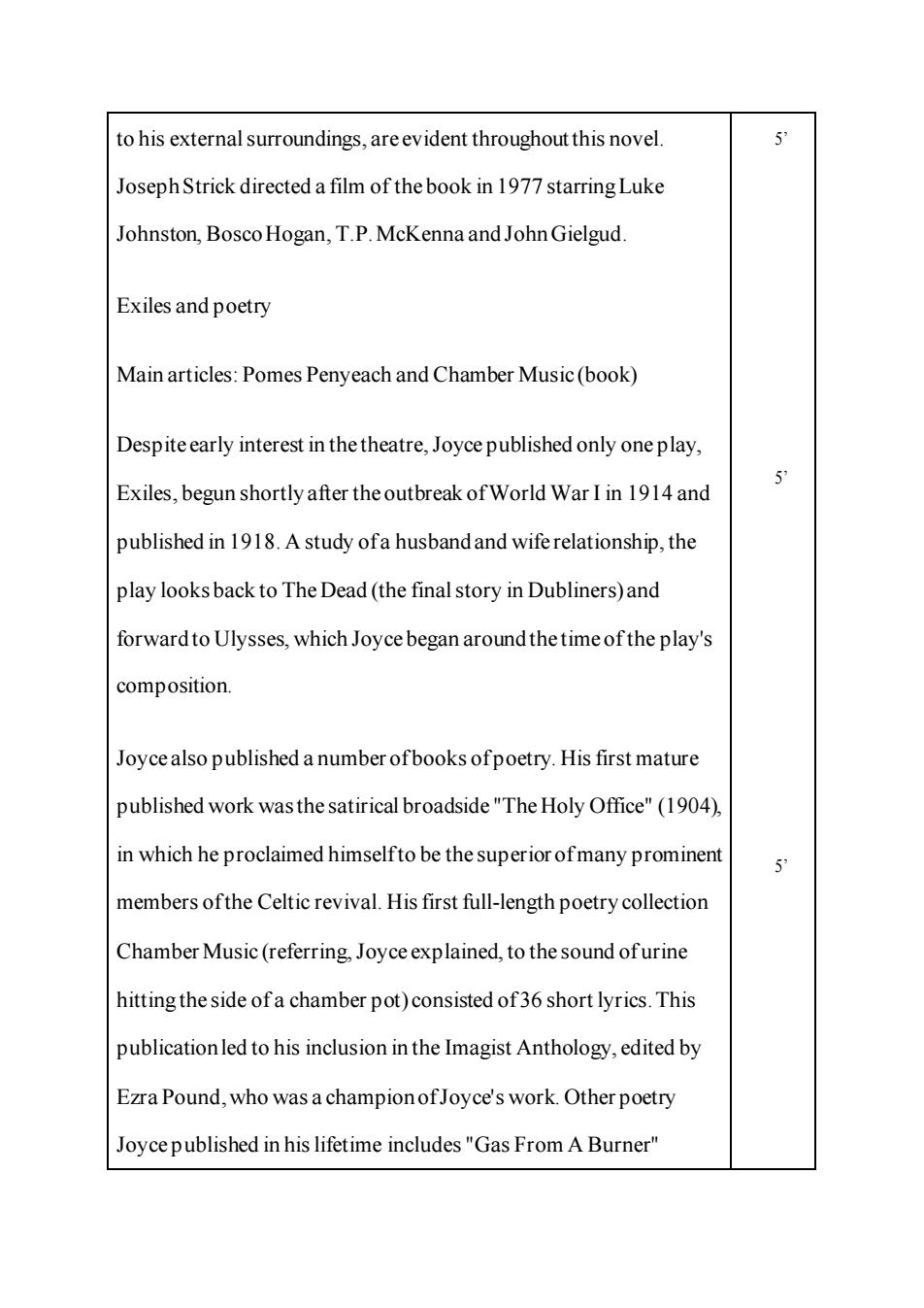
to his external surroundings,areevident throughout this novel Joseph Strick directed a film of the book in 1977 starring Luke Johnston,Bosco Hogan,T.P.McKenna and John Gielgud. Exiles and poetry Main articles:Pomes Penyeach and Chamber Music(book) Despiteearly interest in the theatre,Joyce published only one play, Exiles,begun shortly after theoutbreak of World War I in 1914 and 5 published in 1918.A study ofa husband and wiferelationship,the play looks back to The Dead(the final story in Dubliners)and forward to Ulysses,which Joyce began around thetime of the play's composition. Joycealso published a number ofbooks ofpoetry.His first mature published work wasthesatirical broadside"The Holy Office"(1904). in which he proclaimed himselfto be the superior ofmany prominent 5 members ofthe Celtic revival.His first full-length poetry collection Chamber Music(referring.Joyceexplained,to thesound ofurine hitting the side ofa chamber pot)consisted of36 short lyrics.This publicationled to his inclusion in the Imagist Anthology,edited by Ezra Pound,who was a champion of Joyce's work.Other poetry Joycepublished in his lifetime includes"Gas From A Burner
to his external surroundings, are evident throughout this novel. Joseph Strick directed a film of the book in 1977 starring Luke Johnston, Bosco Hogan, T.P. McKenna and John Gielgud. Exiles and poetry Main articles: Pomes Penyeach and Chamber Music (book) Despite early interest in the theatre, Joyce published only one play, Exiles, begun shortly after the outbreak of World War I in 1914 and published in 1918. A study of a husband and wife relationship, the play looks back to The Dead (the final story in Dubliners) and forward to Ulysses, which Joyce began around the time of the play's composition. Joyce also published a number of books of poetry. His first mature published work was the satirical broadside "The Holy Office" (1904), in which he proclaimed himself to be the superior of many prominent members of the Celtic revival. His first full-length poetry collection Chamber Music (referring, Joyce explained, to the sound of urine hitting the side of a chamber pot) consisted of 36 short lyrics. This publication led to his inclusion in the Imagist Anthology, edited by Ezra Pound, who was a champion of Joyce's work. Other poetry Joyce published in his lifetime includes "Gas From A Burner" 5’ 5’ 5’